 | Note: This is an organic document! It will change. You are responsible for what is on this page, not a copy you made at the beginning of the semester. The dates given in the right column are the due dates, not the day we will work on assignments in class. |  | If there is ever a problem with an assignment (technology problem, don't understand it, can't find it, etc.) do not wait until the due date (or time) to explain your problem. This class is offered every OTHER spring semester. You can't afford to fail it, so don't get behind. 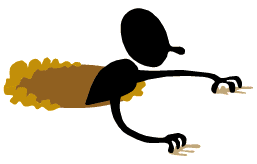
| Staff Paper
Staff Paper/Keyboard |
Assignment Notes: I will not accept assignments done in ink. Please do not use miniscule notes or printing. If something is not clear to you, ASK ME. My schedule is on my door (122) or use the email hyperlink at the bottom of the page.
|
|
Week 1 (beginning
August 28) Note:
There are 28 class meetings this semester. Each one counts 3 points (points come off the top, so you get the extra 16). Tardies deduct 1 point each.
Overview of 20th Century Music
How do you make music "modern"? When music became modern Define music Chapter 1: The Twilight of the Tonal System Chromaticism out of control? The decline of tonality What is the composer thinking? | Eb | Cm | Fm | Db | Gb | D7 | G | | I | vi | ii | bVII | bIII | VII7 | III | | I | vi | ii | V/Gb | Gb | V7/G | G |
12-tone YouTube Nuages gris (Gray Clouds): Liszt Chromatic Mediants (p. 2) See "How to" below "I Want to Hold Your Hand"
C: C G7 Am E
C G7 Am E
F G7 C Am
F G C Where is the chromatic mediant relationship? Exercise: board work - build chromatic mediant and double chromatic mediant chord relationships | Assignments Due:  | Wed | Put this webpage link on your desktop | | |
I. The challenge for the survival of 21st Century Art Music
- Concert halls have become museums
- Audiences are aging and younger generation has little interest in art music.
- Composers have and still are alienating audiences
- Performers, conductors and educators are watering down the repertoire in order to attract new audiences
II. The Solution
- Composers need to get back to writing "mainstream literary music" and competitions need to reward composers writing in this style
- Performers and conductors need to program "mainstream literary music"
- Educators need to teach the value of "mainstream literary music" and not equate it with "vernacular" music.
- Audiences need to be educated by performers, composers, and conductors speaking to them about the music.
- Government funding for performing and creating "mainstream literary music" should increase (Dr. Sy Brandon, Composer)
Sometimes the purpose of harmony/dissonance is voice-leading Omnibus progression: chromatic lines moving in opposite directions "omni" all (all of the notes?)
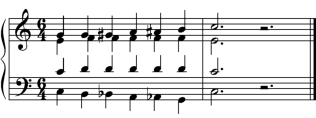
Chipping away at the "rules"!
Chromatic mediant relationships
Tritone relationships
Real
sequences Brief tonicizations
Suspended tonality
Nonfunctional
chord successions
Voice-leading
chords Unresolved dissonances
Interval cycles (moving by intervals that divide the octave
equally; think diminished or augmented thirds)
Example: Liszt:
Grey Clouds
How many of the
above do you hear?
|
Week 2 (beginning
September 4)
No class on Monday for
Labor Day
 Chapter 2: Scale Formations in 20th-Century Music Pentatonic Poor Wayfaring Stranger (D#) Amazing Grace (C#) Nobody Knows (A#) Others? Octatonic scales Modes (Scorch) Make your own scale
Microtonal instrument Pitch Inventory Exercise Part B: Analysis
p. 33 | Assignments Due: 
| Wed | Read Chapter 2 | 
| Wed | Assignment 1 | | | How to find Chromatic Mediants: Find all mediants (M3 and m3 above the root of the original chord and M3 and m3 below the root of the original chord) Build "like" chords (If the original chord is major, the 4 chromatic mediants will be major; if the original chord is minor, the 4 chromatic mediants will be minor)
How to find Doubly Chromatic Mediants: Look at the 4 chords you have above and change the quality (major to minor, or minor to major) Doubly Chromatic Mediants must be the opposite of the original chord (major or minor) Of these chords, only 2 will work because NO notes in the resulting chord can be the same as the original chord.
| | | |
Bartok: Music for Strings, Percussion, and Celesta, IV
Debussy: Preludes, Book 1, No. 6, "Footprints in the Snow" ("Des pas sur la neige") Zwilich: Piano Trio Debussy: The Joyous Isle (L'isle joyeuse) mm.145 @ 44sec Grieg: "Shepherd Boy," Op. 54, No. 1 Scriabin: Prelude, Op. 74, No. 5
Casella: Eleven Children's Pieces, "Siciliana"
Debussy: Preludes, Book I, "Sails" (Voiles") mm.38-44@1:52
Lutoslawski: Livre Pour Orchestre |
Week 3 (beginning
September 11)
Chapter 3: Vertical Dimensions Modern Harmonizations of "O Sacred Head" Non-tertian Harmony Extended Tertian Harmony Debussy: Preludes, Book 11, "Heaths" ("Bruyeres")
Prokofiev:
Sonata for Flute and Piano Op. 94 Added Notes
Debussy: Preludes, Book 1, "The Girl with the Flaxen Hair" ("La fille aux cheveaux de lin"), m. 23-24@1:16 Split Chord Members Copland: Vitebsk Open 5th ChordsOrff: Carmina Burana, "Veris leta facies" Quartal and Quintal Chords Copland: Piano Fantasy, mm.20-24@0:45 Secundal Chords
Ives: Piano Sonata No. 22(Concord), II Mixed Interval Chords Example, p. 57 Whole-tone Chords
Scriabin Etude
Op. 56 No. 4 Polychords Stravinsky: Petrushka, Second Tableau @0:35
Chapter 4: Horizontal Dimensions New stylistic features of post-tonal melody wide range large leaps Boulez: Le marteau sans maitre, III chromaticism Bartok: Music for String Instruments, Percussion, and Celesta, I less vocal (angular) melodies Boulez: Le marteau sans maitre (The Hammer without a Master), IX Romantic influence remains Walton: Violin Concerto, I Melodic organization still use traditional compositional devices (repetition, repeat, sequence, diminution, augmentation, etc.), but also new devices: Motives (pitch class cells) a collection of intervals, usually 3 or 4 notes Webern example in textbook
12-tone melodies (score p. 73) Schoenberg: Wind Quintet, Op. 26, III
Voice-leading Parallelism 5ths, octaves Barber: String Quartet No. 1, Op 11, II (Adagio) at 4:00 Chordal parallelism/harmonic parallelism/planing Bartok: Piano Concerto No 2 Dissonance Former reasons for dissonance: tension requiring resolution or decorative Now, the "emancipation of the dissonance" (Schoenberg)
Stravinsky: The Soldier's Tale, "Great Chorale" Tintinnabuli Technique
Part: Magnificat Antiphons, "O Konig aller Volker" | Assignments Due:  |
Mon | Read Chapter 3 |  |
Mon | Assignment 2 Note: Please use enharmonic spelling for simplicity and don't use a key signature for these exercises. |  | Wed |
Read Chapter 4 | | | | |
It is conceivable that what is unified form to the author or composer may of necessity be formless to his audience. ~ Charles Ives 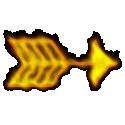
| Heads up! Be thinking about your first composition assignment. Due: Week 5 | | | |
|
Week 4 (beginning
September 18) Chapter 5: Harmonic Progressions and Tonality Planing
Debussy: Preludes, Book I, "The Engulfed Cathedral" Pitch-centricity establishing a tonal center through non-traditional means Britten: Serenade for Tenor Solo, Horn, and Strings, Op. 31, "Sonnet" m.33@3:30 Polytonality Debussy: Preludes, Book II, "Fireworks" ("Feux d'artifice") m.91@3:50 Ives: Variations on America @3:20 Polytonality Atonality Boulez: Le marteau sans maitre (The Hammer without a Master), IX Pandiatonicism Using a diatonic scale without functional tonality
Stravinsky: Serenade in A, I m.52 @ 2:20 Piano Puzzler DebussyLondon Bridge Yesterday Ain't Misbehavin' This Land Is Your Land Skip to My Lou Silent Night Happy Birthday Ravel
Hey Jude
Alouette Home on the Range Nowhere Man Aaron CoplandAuld Lang Syne Oh Shenandoah Happy Birthday Bela BartokJingle Bells This Old Man Camptown Races Richard StraussI've Been Working on the Railroad Messiaen Every Night When the Sun Goes Down Summertime | Assignments Due: For the creative spirit, limits are useful.~ Leon Fleisher Ravel Piano Concerto for the Left Hand (Cadenza) |
Week 5 (beginning
September 25) | Assignments Due:  | Wed | Composition 1: Debussy Compositions Finale file is due one hour before class time | | | | | | | | |
|
Week 6 (beginning
October 2) Chapter 6: Developments in Rhythm Perceived rhythm Webern: Variations for Piano, Op. 27, II
Chopin: Prelude Op. 28 Changing time signatures Nontraditional time signatures Polymeter Bartok: String Quartet No. 3, II Mvt II at 5:00 2nd example after 7:30 Ametric Berio: Sequenza I (Proportional notation) Schwantner: And the Mountains Rising Nowhere Added values Nonretrogradable rhythms Tempo modulation Polytempo Carter: String Quartet No. 1 at 1:00 Serialized rhythm (stay tuned) Isorhythm Create a "color" by selecting a set of pitches (for example, the 5 pitches: B, E, C#, D, G) Create a "talea"* by selecting a set of durations (for example, the first 6 durations that comprise the rhythm of 'Happy Birthday') Put them together, cycling both over and over Eventually, the beginnings of the 2 will coincide again which will complete the 'isorhythmic cycle.'
If the color and the talea have equal parts, that is an ostinato! *a medieval term for rhythmic pattern (as opposed to a melodic one). Graphic notation It is not possible to compose or perform "outside the box" Artikulation (Ligeti) Meta HP (Xenakis) Students write graphic notation Epitaph for Moonlight Vocal music Gravity (Matsumoto) Open Me (Ewen) Shepard tone Shepard tones (detectable) Audio illusion1 Audio illusion2 Animated Graphical Score of Stravinsky's The Rite of Spring | Assignments Due:  | Mon | Read Chapter 6 | | | | | | | | |
Added values 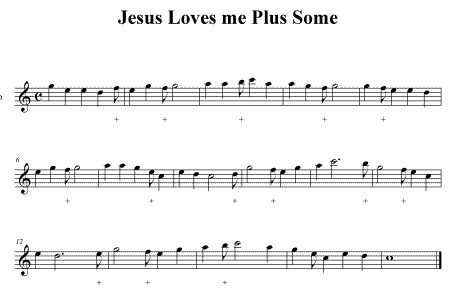
Formula for Tempo Modulation The following formula illustrates how to determine the tempo before or after a metric modulation, or, alternately, how many of the associated note values will be in each measure before or after the modulation: | new tempo | = | number of pivot note values in old measure | | old tempo | number of pivot note values in new measure |
Thus if the two half notes in 4/4 time at a tempo of quarter note = 84 are made equivalent with three half notes at a new tempo, that tempo will be: | x = 126 Procedure 3 Stage Format |
- Determine the regular division of the beat
- “Transition” or “pivot” using an irregular division of the beat
- Complete the modulation: the irregular division of the beat becomes the regular division of a new beat (you must maintain the earlier duration, but now it has a new tempo)
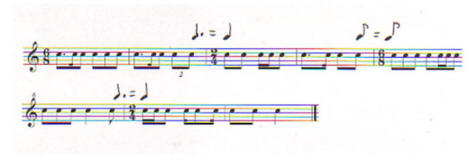
|
Week 7 (beginning
October 9) Chapter 6: Rhythm, cont.
Review for MidTerm Exam MidTerm Exam Wednesday | Assignments Due: |
Week 8 (beginning
October 16)
Go over midterm Exam
Chapter 8: Neoclassicism "A reaction against the style of late Romanticism"
Octet
for Wind Instruments (1923) "Sinfonia"
Stravinsky Rite of Spring
Example 2 Example 3 Contrast with Tchaikovsky Swan Lake StravinskyFascinatin' Rhythm You Get a Line and I'll Get a Pole I Dream of Jeannie with the Light Brown Hair Auld Lang Syne Fiddler on the Roof/If I Were a Rich Man
Chapter 9: Non-serial atonality
Schoenberg: String
Quartet No. 2, Mvmt. 4 ("I feel the air of other planets . . .")
Intro to Set Theory
Set Theory Explained 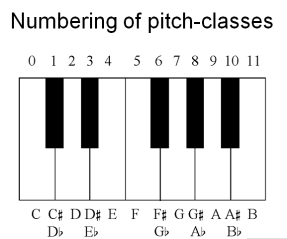
Using
clockface
 | Assignments Due:
Schoenberg: Three Piano Pieces (1909), Op. 11, No. 2 Pitch-class set analysis Schoenberg: String Quartet No. 2, Mvt. 4 (Assez rapide) Schoenberg: String Quartet No. 2, Mvt. 1 reminds me of Twilight Zone Webern: Six Bagatelles for String Quartet, Op. 9 (1913), V Crumb: Madrigals, Book 1 (1956), No. 1 Schoenberg: Klavierstucke, Op. 11 #1 Analysis Interval Vectors Normal order: the pitch order that spans the smallest possible interval Best normal order: normal order or its inversion - whichever one puts smallest intervals to the left Prime form: resulting series of numbers Quick Set Theory (straight to the prime form) Line up pitches in ascending order and add the octave Find the largest interval and place those two notes on opposite ends (this is the
normal order) Assign numbers both ways and the best direction wins (this is the
best normal order) Assign numbers to the best normal order (this is the
prime form)
|
Forte numbers |
Week 9
(beginning October 23) | Assignments Due: |
Week 10
(beginning October 30) Arnold Schoenberg (1874-1951) tonal music (1895-1910) atonal music (1910-1920) serial music (1920-1951)
(1933 came to U.S. and taught from 1936-1945)
12-tone Greatest Hits
Chapter 10: Classical serialism Serialism 12-tone Technique The Matrix Simple 12-tone example
Schoenberg: Suite for Piano (Op. 25), Prelude
Matrix generator Schoenberg Piano Puzzler 
Schoenberg Klavierstudk Op. 33b 
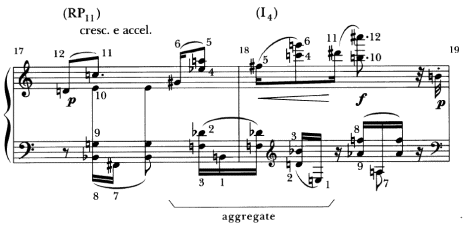

| Assignments Due: 12-tone
Matrix Construction handout 
A set containing tonal cells (row from
Violin Concerto, Alban Berg, 1935) Analysis 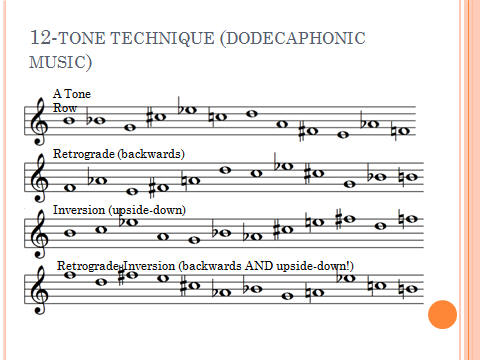
In preparation for serial compositions:
The Owl
and the Laser Bat Awesome demonstration using nursery tunes
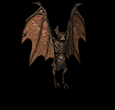 |
Week 11 (beginning
November 6)
Monday and Wednesday: Piano lab | ` |
Week 12 (beginning
November 10) Electronic Music Theramin
on Wednesday!
Experimental instruments
Roli Seaboard Piano Chapter 13: Serialism after 1945 Integral serialism
The World's Ugliest Piece of Music
Three Compositions for Piano (Babbitt) p. 266 earliest examples of "total" serialism
Structures (Pierre Boulez) p. 270, 280-81 Read paragraph summary on p. 279
| Assignments Due:  | Mon | Composition
2: 12-tone Finale file is due one hour before class time | | | | | | | | |
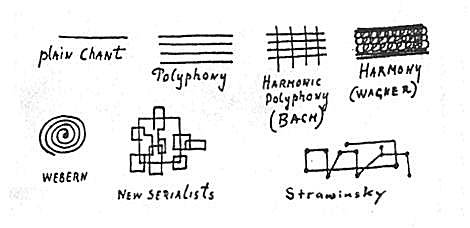
Stravinsky's view of the evolution of music Stravinsky Some historians feel that the
single most important composition of the 20th Century was Igor Stravinsky’s Le Sacre du Printemps The Rite of Spring Premiered in Paris in 1913 The more constraints one imposes, the more one frees one's self. And the arbitrariness of the constraint serves only to obtain precision of execution. ~ Igor Stravinsky |
Week 13
(beginning November 20) Chapter 14, 15: Chance, Choice; Minimalism
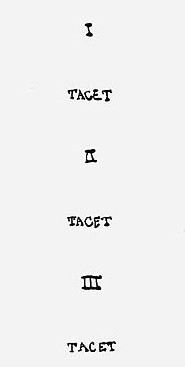
In Bb
Happy Thanksgiving!
 | Assignments Due:  | Mon | Read Chapter 14 and 15 There will be a quiz | | | | | | | | | | | | |
What can be left to the performer's choice? Instrumentation and/or number of performers Dynamics Rhythm (Ex: proportional durations p. 125) Tempo Pitch (Ex: general instructions of high or low) Form (Ex: choosing the order or selecting sections)
Stockhausen (Klavierstuck X) p. 289 (read) and p. 290 (score) Scores can be traditional graphic text (p. 296)
Read Chapter 14 for other ideas. |
Week 14 (beginning
November 27) Beyond Minimalism: Amalgamation of techniques Tavener: The Protecting Veil (Score p. 312) Svyati Boje (1995) "Holy One" Setting the Stage for the 21st Century | Assignments Due:  |
Mon | Compose an aleatory composition that can be performed in class |  |
Wed | Bring examples of 21st century "art music" | | | | | | | | | | | | |
|
Week 15
(beginning December 4) Last class day:
Wednesday, December 6 Final Exam Study Guide Final Exam:
Monday, December 11 at 11:30am Beauty Amid the Discord: Music in the 20th Century some of the philosophy after the fact Classical Music: 2005 and Beyond 5 Modern Classical Pieces for Pop Listeners 5 Pop Recordings for Classical Fans Alex Ross Music and Food |  | Mon |
Composition
Write your own piece with a partner (12 meas., 48 beats using graphic notation) | | | | |  | Wed | Review for Final Exam | | | | |
Twentieth Century Terms from Kostka 20th Century Music in 16'54" Who are the Successors? 

It really is! |

|
20thCenturyMusicQuiz |
| | Mikrokosmos score (Bartok) | |
Schoenberg Klavierstucke Op. 11, No. 1 (flash file) George Crumb Whale Songs | Piano Puzzler Satie (March 30, 2005) | |
Staff Paper Staff Paper/Keyboard |
Seating Chart |
Created and Maintained by Vicky V. Johnson